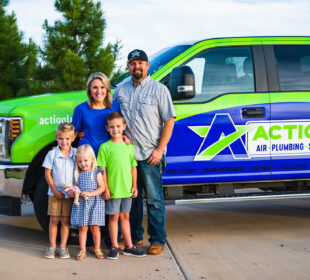Many homeowners rely on a gas furnace to heat their homes in the cold winter months. They love the added warmth and cost-effective gas heating. But there are also a few added safety precautions that every gas furnace owner should be aware of. And by following just a few safety tips, every homeowner can rest assured that their home will be warm, cozy, and danger free.
Carbon Monoxide
Gas furnaces offer life-saving safety features to protect you and your loved ones from carbon monoxide, a deadly gas produced during the combustion process. This odorless gas is toxic if it collects inside your home. Fortunately, most furnaces are equipped with a sensor that turns the furnace off if a substantial amount of carbon monoxide is detected. When you have your HVAC system serviced each year, be sure to ask your service tech to inspect the carbon monoxide sensor to ensure that it is operating correctly.
It is also essential to have backups in place for added safety. Carbon monoxide monitors can be installed throughout your home to ensure that the gas level never reaches a dangerous level. The monitors look much like a smoke detector and should be installed outside each bedroom in your home. Check the monitors and replace the batteries regularly to ensure the safety of your loved ones.
The Heat Exchanger
Over time, small cracks can develop in your furnace heat exchanger. These cracks could allow carbon monoxide to leak into your home. Ask your HVAC expert to carefully examine the heat exchanger for leaks during your annual inspection. This is also the time to request that they inspect the burners. The flame on your furnace should always burn blue. You can see the flame when the furnace is running, which is a good time for you to make periodic visual inspections. If you notice that the flame is yellow or orange, call to schedule a service appointment with your trusted HVAC team.
The Front Access Panel
Newer model furnaces will not function with the front access panel removed. This is a safety feature to reduce the potential for carbon monoxide poisoning. However, older units do not all offer this safety feature. Be sure that the front access panel is always secured in place when your furnace is in operation. The front panel ensures that the carbon monoxide is being removed through the exhaust ventilation in the furnace and not escaping into your home.
A Safety Buffer
It is vital to keep all combustible materials away from your furnace. This includes any items that are paper or fabric and could catch fire easily. Other things like solvents, paint, and gasoline should be kept far away from the unit. It is generally a good idea to keep a clear area of about six feet on all sides of your furnace. It ensures that you will not need to worry about a potential fire. And it provides adequate space for servicing the unit.
Furnace Filters
Your furnace filter is designed to eliminate dust and dirt that could damage the components of your furnace. When the filter becomes cakes with debris, it can reduce the unit’s airflow and decrease its efficiency. Inspect the filters regularly and replace as needed. This will also help reduce the dust in your home.
A gas furnace is a great choice to keep your home warm. But just like any mechanical device, it requires a little care and maintenance each year. Call us to schedule your HVAC annual inspection and ensure that your home will be warm and safe throughout the winter.


